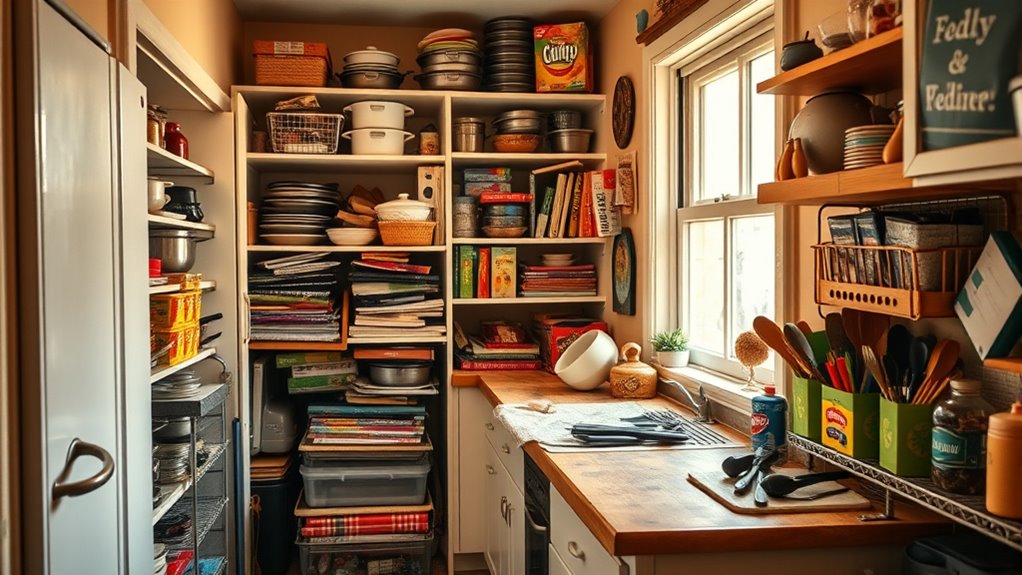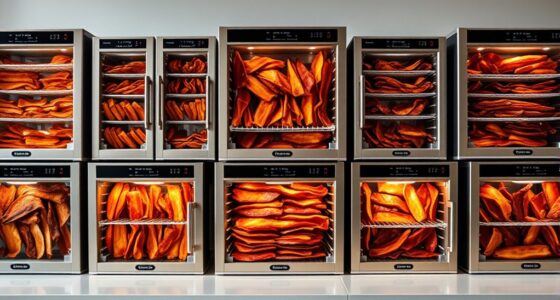Your kitchen feels cramped mainly because of poor layout, which limits movement and creates bottlenecks. Oversized appliances and cluttered surfaces cut down on workspace, while inefficient storage leaves valuable space underused. Lack of natural light and bad lighting make the space seem smaller, and structural barriers or tight entry points block flow. If you keep these issues in mind, you’ll uncover how better design can transform your kitchen into a more open, functional space.
Key Takeaways
- Poor layout and traffic flow create bottlenecks, restricting movement and making the space feel crowded.
- Insufficient vertical and smart storage solutions lead to cluttered surfaces and limited open space.
- Overdecorating and disorganized cabinets increase visual clutter, shrinking perceived room size.
- Lack of natural and proper artificial lighting makes the kitchen appear smaller and more confined.
- Large, improperly placed appliances and inefficient work zones reduce functional space and cause congestion.
Poor Layout Planning and Traffic Flow
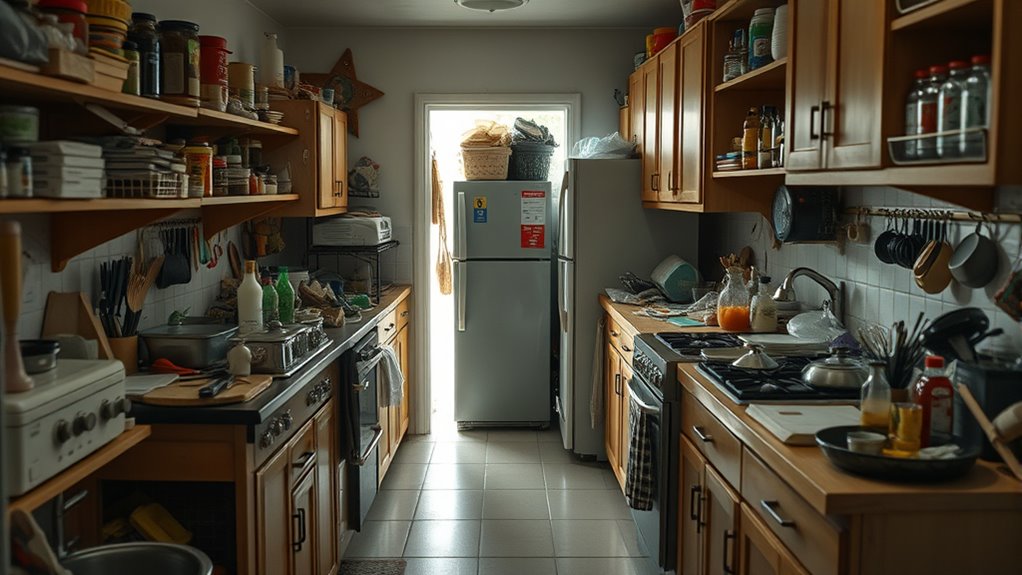
Poor layout planning and traffic flow are common reasons your kitchen feels cramped. When you don’t plan the layout carefully, circulation space becomes restricted, making it tough to move smoothly between work zones. Failing to allocate at least four feet of clearance between countertops creates congestion and slows down your workflow. Incorrect placement of appliances and cabinets can block pathways, forcing you to navigate around obstacles. Overcrowding with too many elements or furniture reduces open space, heightening the cramped feeling. Not considering traffic patterns during design leads to bottlenecks, limiting easy access to key areas like the sink, stove, or refrigerator. Proper layout planning guarantees a natural flow, providing enough circulation space so you can move comfortably and work efficiently in your kitchen. Additionally, space optimization techniques can further improve functionality and reduce clutter. Incorporating smart storage solutions helps maximize available space and maintain an organized environment, further alleviating the cramped sensation. To enhance overall flow, using self watering plant pots in your kitchen can help keep your space organized and reduce clutter by providing a neat, integrated solution for plant care.
Insufficient Counter and Storage Space

When your countertops are cluttered, it’s tough to find enough space for meal prep, making everything feel cramped. Limited cabinet storage forces you to leave appliances and utensils out in the open, adding to the chaos. Without enough or well-designed cabinets, disorganization quickly takes over, shrinking your kitchen’s functionality. Incorporating functional storage solutions can help maximize space and reduce clutter. Additionally, installing smart storage options like built-in shelves or pull-out drawers can optimize every inch of available space, especially when designed with cultural intelligence to consider diverse user needs and preferences. Being mindful of home essentials can guide you in choosing storage options that suit your lifestyle and household habits.
Cluttered Countertops Limits Workspace
Have you ever noticed how your countertops become cluttered, making it hard to prepare meals efficiently? Cluttered countertops markedly reduce your workspace, forcing you to clear items constantly. When your surface area is overcrowded, your workflow slows down, and the kitchen feels cramped. Excess items on the countertop often stem from insufficient storage space, leading you to leave things out instead of putting them away. Overstuffed surfaces not only limit movement but can also block natural light, making the kitchen appear darker and smaller. Utilizing digital organization tools can help you plan better storage solutions and prevent clutter buildup. Implementing efficient storage solutions can maximize your available space and keep your countertops clear. Additionally, understanding how dreams reflect subconscious thoughts can inspire creative solutions for organizing your space more effectively. Keeping your countertops clear and organized creates more functional space, boosts safety, and helps your kitchen feel more open and inviting. Additionally, proper organization can prevent the buildup of clutter in the first place, maintaining a more spacious environment. Clearing clutter isn’t just about tidiness—it’s essential for a more comfortable, efficient cooking environment.
Insufficient Cabinets Reduce Storage
Insufficient cabinet space forces you to store items on countertops or in less accessible areas, which quickly leads to clutter and a cramped feel in your kitchen. When your cabinets don’t extend to the ceiling, you lose valuable vertical storage, reducing overall capacity. This makes it harder to keep pantry items, cookware, and appliances organized, leaving counters crowded and limiting workspace. Small or poorly planned cabinets often can’t accommodate modern appliances or larger cookware, so you leave these out in the open. Shallow or underutilized vertical storage options also contribute to clutter, making your kitchen appear smaller than it is. Without adequate cabinet space, your kitchen feels cramped because clutter takes over, and your storage options are limited, trapping you in a space that’s far less functional. Active listening and communication about storage needs can help identify solutions to improve space efficiency, especially considering cabinet design innovations. Exploring storage optimization strategies can further maximize your existing space and reduce clutter.
Cluttered Surfaces and Overdecorating
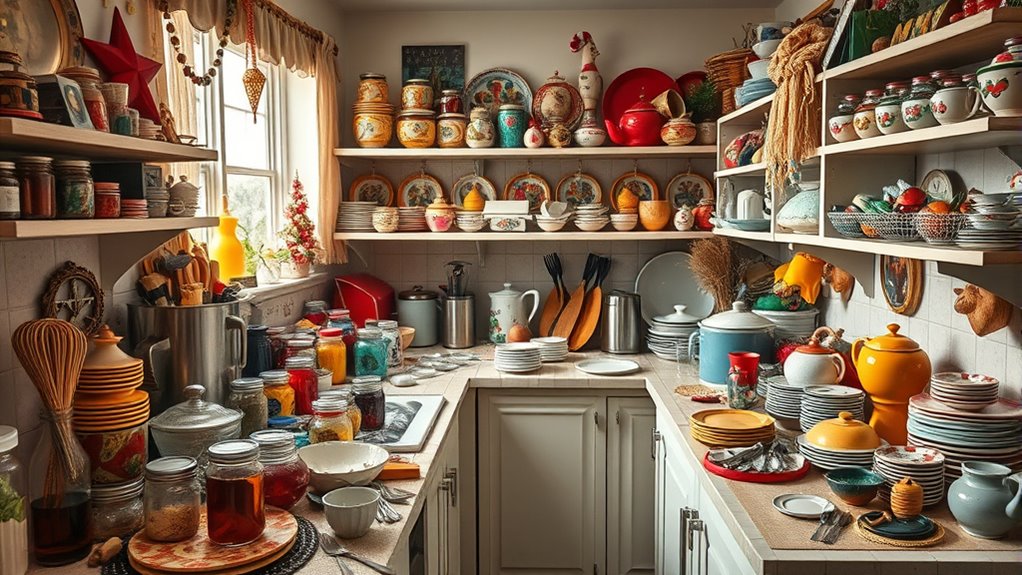
When your countertops are filled with too many ornaments, utensils, and small appliances, your workspace becomes crowded and chaotic. This overdecorating reduces the sense of openness, making your kitchen feel smaller than it is. Keeping surfaces clear and organized helps create a more spacious and functional environment.
Excess Decorative Items
Excess decorative items can quickly make your kitchen feel cramped by creating visual clutter on countertops and shelves. When you display too many decorative accessories, your surfaces become crowded, drawing attention to disorder instead of style. This cluttered look reduces the perception of space and openness, making the room feel smaller. Additionally, overdecorating can obstruct functional areas, slowing down your workflow and increasing frustration. Decorative objects that aren’t stored properly add to the chaos, overwhelming your senses and diminishing the room’s spacious feel. Simplifying your decor by limiting decorative items to essentials or organized displays helps clear visual clutter. This small change can greatly enhance the sense of openness, making your kitchen feel larger, more inviting, and easier to navigate. Being mindful of visual clutter and how it impacts your space is essential for creating a more open and functional kitchen environment. Incorporating smart storage solutions can further help manage clutter and optimize space efficiency.
Overfilled Countertops
Have you noticed how cluttered countertops can make your kitchen feel smaller? When your countertops are filled with utensils, small appliances, and decorative items, your workspace shrinks by up to 50%. This clutter hampers your workflow, forcing you to navigate around obstacles instead of moving smoothly through meal prep and cleaning. Excessive decorations and multiple small items create visual chaos, making the space feel cramped and overwhelming. A cluttered surface not only reduces your efficiency by 20% but also distracts you from tasks. By maintaining a minimalist approach and limiting countertop items to essentials, you can instantly make your kitchen appear larger and more open, transforming a cramped space into a functional, inviting area.
Ineffective Use of Vertical Space
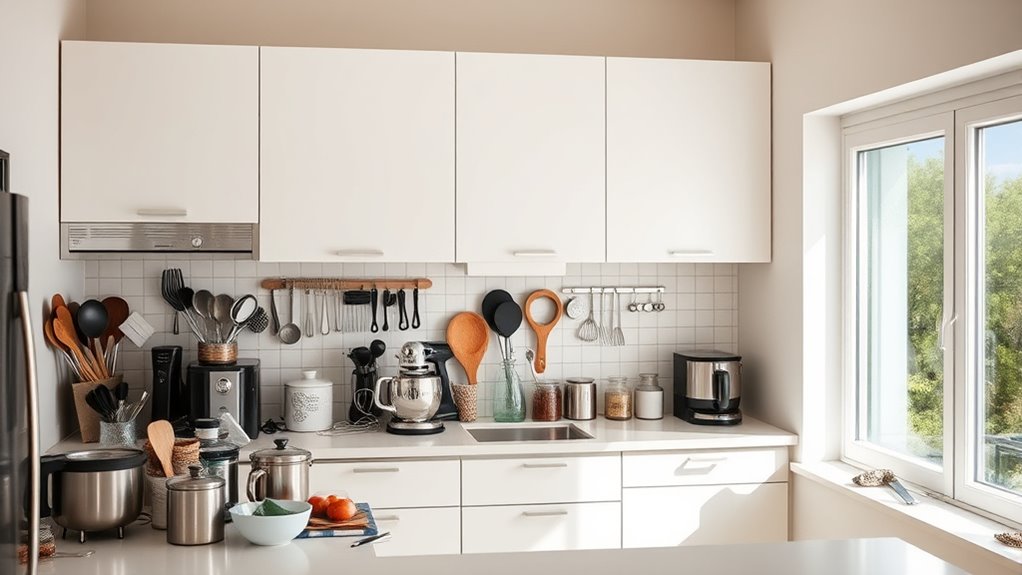
Many small kitchens miss out on valuable storage by not fully utilizing vertical space. When you neglect this area, you limit your storage capacity and keep clutter lingering on countertops and in cabinets. Extending cabinets to the ceiling can boost storage by up to 30%, freeing up counter space and making your kitchen feel less cramped. Installing open shelves or wall-mounted racks creates easy access to your most-used utensils and cookware while keeping clutter off surfaces. Vertical storage solutions like hanging pot racks or magnetic knife strips also free up drawer and counter space, making your kitchen more organized. Additionally, incorporating innovative design elements such as pull-out pantry shelves or corner units can further optimize vertical areas. Recognizing the importance of efficient space utilization can help you transform your small kitchen into a more open and functional space. Wasting vertical space is a missed opportunity for maximized storage capacity, which can significantly improve your kitchen’s usability. Ignoring vertical space wastes potential. By maximizing wall areas, you’ll create a more open, functional kitchen that feels larger and less cluttered.
Lack of Natural Light and Poor Lighting Strategies
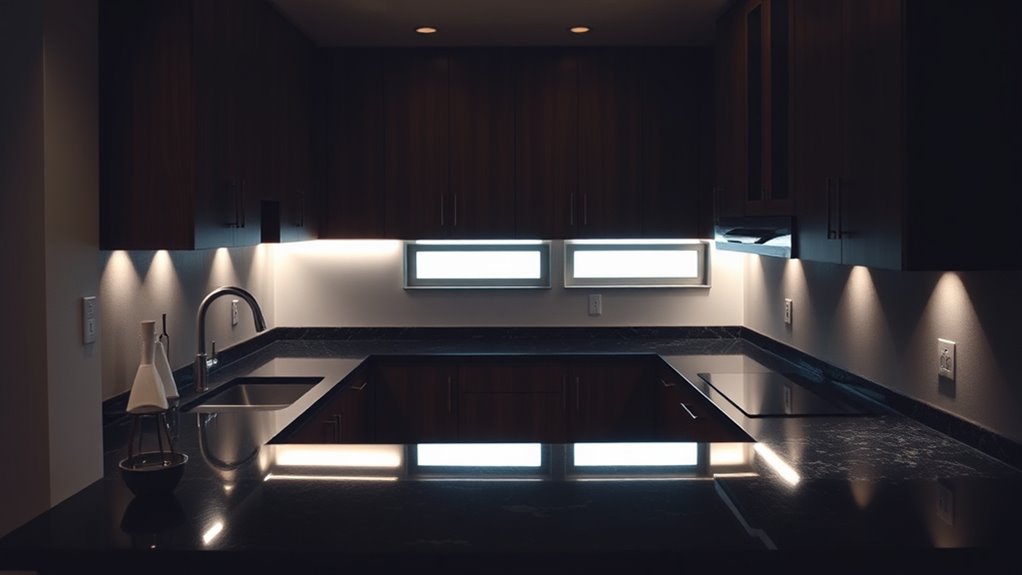
A lack of natural light can make your kitchen feel smaller and more confined, since daylight plays a crucial role in creating an open, airy atmosphere. Without enough natural light, your space feels darker and less inviting. Good lighting design is essential; inadequate task or ambient lighting can cast shadows and dark corners, emphasizing cramped areas. To improve this, consider larger or strategically placed windows to maximize natural light entry. Reflective surfaces like glossed cabinets, mirrors, and shiny tiles bounce light around the room, enhancing brightness and making the space feel larger. Poor artificial lighting, such as heavy fixtures or misplacement, can create a gloomy environment that shrinks the perceived size of your kitchen. Proper lighting strategies and reflective surfaces can considerably boost the room’s openness and comfort. Additionally, lighting design plays a key role in transforming the perception of space and should be tailored to enhance natural light sources.
Overly Large or Bulky Appliances
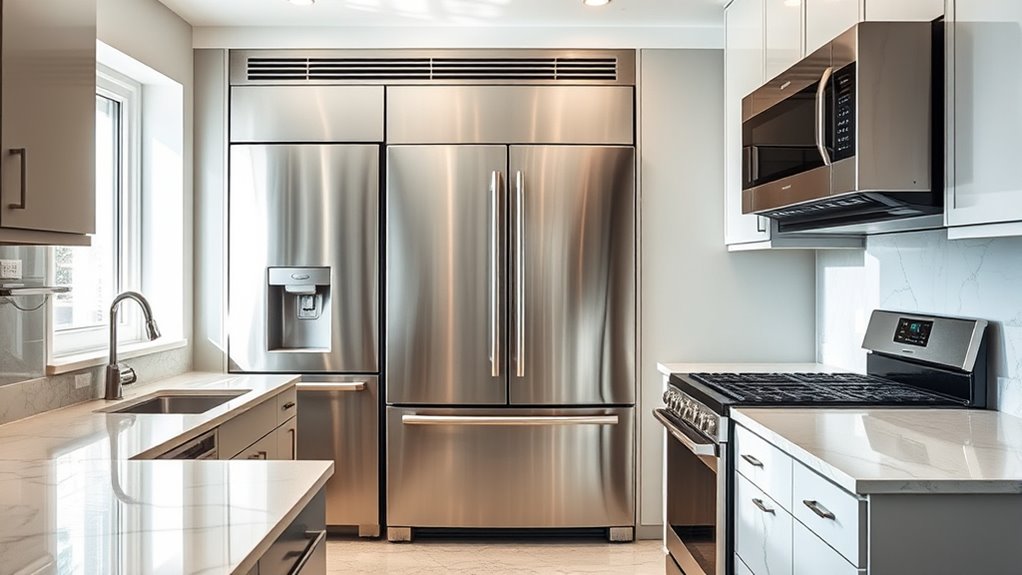
Large or bulky appliances can quickly turn a small kitchen into a cramped space by dominating the room visually and physically. Oversized refrigerators, double ovens, or heavy-duty dishwashers take up valuable kitchen space, leaving little room for movement or storage. Standard fridge widths of 36 inches can consume significant wall space, reducing cabinetry options and creating congestion. Heavy appliances often require extra clearance for opening and maintenance, further limiting your workspace. Replacing these with slimline or integrated alternatives can free up to 30% of your kitchen floor area, making it feel more open and functional. To maximize your space, choose appliances designed for small kitchens, and keep pathways clear of bulky appliances that can create bottlenecks and hinder workflow.
Inefficient Work Zones and Poor Workflow
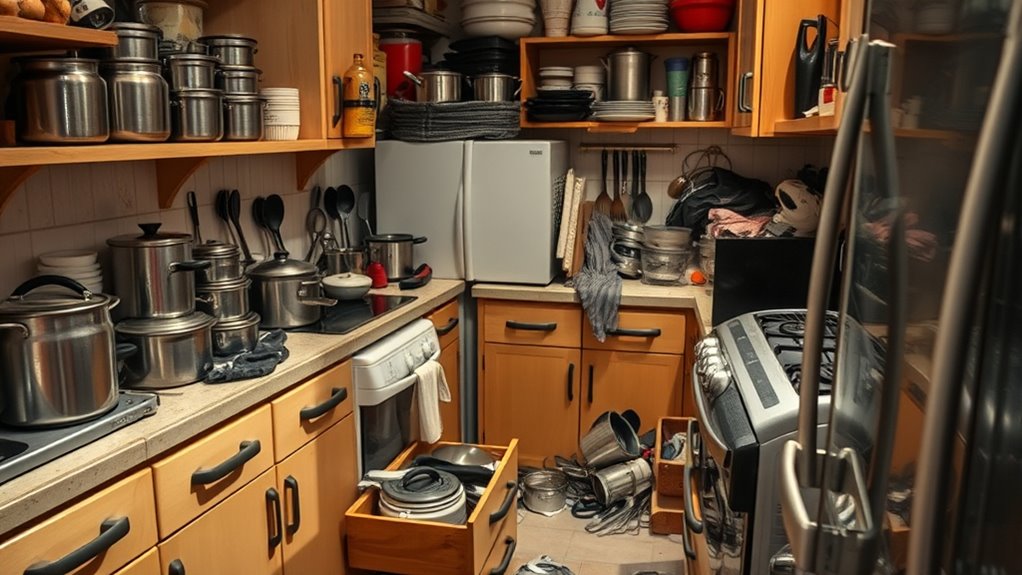
Inefficient work zones and poor workflow can make your kitchen feel cramped even if the space itself is adequate. When your work zones aren’t well-planned, you’ll find yourself walking unnecessary distances between the sink, stove, and refrigerator—sometimes over 30% longer. This increases clutter and creates bottlenecks, where multiple people can’t work simultaneously without blocking pathways or accessing essential items. Without clear activity zones, you’re forced to cross through cluttered areas, adding to the congested feeling. Overlapping zones, like placing the fridge far from prep spaces, also contribute to clutter buildup. When you neglect to optimize the placement of frequently used items, it results in constant trips and awkward movements, making your kitchen seem smaller and less functional than it actually is.
Excessive Visual Clutter and Poor Organization
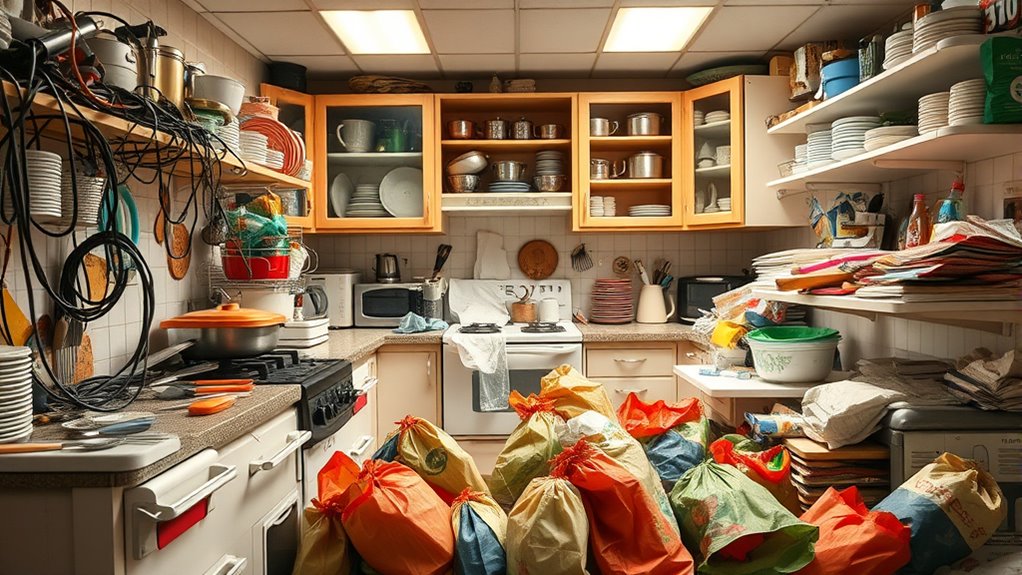
Excessive visual clutter and disorganized spaces can make your kitchen feel much smaller than it truly is. When countertops are overloaded with small appliances, utensils, and decorative items, the space appears chaotic and cramped. Poor organization, like disorganized cabinets and drawers, forces you to search for items, adding to the clutter. This chaotic appearance also reflects poorly on lighting, creating shadows that shrink the visual space. To improve the sense of openness, consider:
- Clearing countertops of unnecessary items
- Using smart storage solutions to organize utensils and appliances
- Keeping surfaces minimal and tidy for better light reflection
Structural Barriers and Poorly Designed Entry Points

Structural barriers like support columns and load-bearing walls can considerably limit your kitchen’s usable space and create visual obstacles that make the area feel cramped. Load-bearing walls often divide the space into smaller, disconnected zones, reducing open flow. Poorly placed or narrow entry points, such as tight doorways or passageways, restrict movement and hinder easy access between areas. Inadequate clearance around doors and appliances further blocks pathways and makes navigation difficult. When internal walls segment the kitchen, it limits natural light and creates a sense of confinement. Without an open-plan design or proper door and window placement, your kitchen lacks the visual and physical openness needed for a spacious feel. Addressing these structural issues can instantly improve functionality and reduce the cramped sensation.
Frequently Asked Questions
What Has Replaced the Kitchen Triangle?
You might wonder what’s replaced the kitchen triangle now. These days, modern designs favor activity zones—grouping related tasks like prep, cooking, and cleaning close together. Flexible layouts with islands or peninsulas make your space more open and adaptable. Instead of fixed distances, this zoning approach lets you multi-task comfortably, even with multiple people. It’s all about creating a more efficient, user-friendly flow tailored to your lifestyle.
How to Make a Kitchen Feel More Open?
Imagine you’re channeling your inner Marie Kondo. To make your kitchen feel more open, keep window treatments minimal, letting in plenty of natural light. Incorporate reflective surfaces like glossy tiles and high-gloss cabinets to bounce light around. Use light, neutral colors on walls and cabinets, and remove unnecessary upper cabinets or extend them to the ceiling. Open shelving and minimal hardware also help reduce visual clutter, making your space feel larger and brighter.
What Is the Triangle Rule for Kitchens?
The triangle rule for kitchens connects your cooktop, sink, and refrigerator to improve workflow and reduce unnecessary steps. Ideally, these points should be 3 to 9 feet apart, with a total perimeter between 13 and 26 feet. While it was designed for small, single-user kitchens, many modern layouts now focus on activity zones instead of strict adherence to this rule.
What Was the Point of the Kitchen?
The point of the kitchen is to serve as a dedicated space for preparing, cooking, and storing food efficiently. It’s designed to keep your tasks organized and streamlined, allowing you to work comfortably. When your kitchen feels cramped, it’s usually because the layout doesn’t optimize this primary purpose. To fix this, focus on improving storage and traffic flow, so the space supports your cooking needs without feeling overwhelmed.
Conclusion
Your kitchen shouldn’t feel like a maze—you’re the captain steering through clutter and poor design. By tackling layout flaws, maximizing space, and clearing clutter, you can transform it into a smooth-flowing engine rather than a cramped closet. Think of your kitchen as a well-orchestrated symphony, where each element plays its part harmoniously. With a few tweaks, you’ll create a space that breathes easy and works effortlessly, turning chaos into calm.
